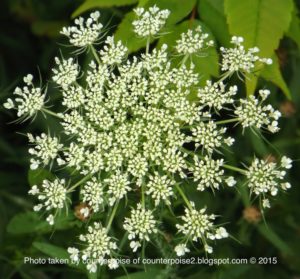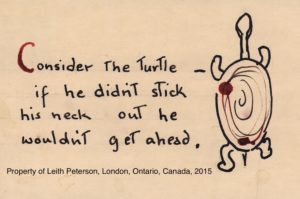Disclaimer: My references to the writings of other people–both indigenous and non-indigenous–do not in any way imply that they share my views on this matter. The opinions expressed here are my own, and do not necessarily reflect the views of my family, friends or associates.
Note: The photos included with this post were taken by me. The turtle artwork is by my mother, Jay Peterson (1920-1976). Although none of these images have any direct connection with the material being discussed, Helin stresses, in Dances With Spirits, that “we are inseparable from nature.” My regular walks through my neighbourhood remind me of this.
Calvin Helin is a “member of the Tsimshian Nation,” and is originally from the community of Lax Kw’alaams, which is on the Northwest coast of the province of British Columbia, in Canada. Now he lives in Vancouver, which is a city in the southern part of the same province. He is “the son of a hereditary chief,” and an “entrepreneur, lawyer and best-selling author.”
His book, Dances With Spirits: Ancient Wisdom for a Modern World (2014), “guides readers in applying ancient wisdom for a better understanding of today’s complex modern world. Millions crave spiritual fulfillment in a time of broken social relations. Yet most are confused as to why their deepest yearnings for meaning and a kinder, gentler way of life are becoming more distant. . .”
“. . .We live in a skewed society, focused on technology and money. Through understanding our true nature, a better existence can be created.”
Before I start my Dances With Spirits review, I will briefly discuss two of Helin’s other books, which I have also read.
 |
| View from bridge, London, Ontario, May 25, 2014 |
A. Dances With Dependency: Indigenous Success Through Self-Reliance (2006)
In Dances With Dependency, Helin argues that “[t]he current governance system is not only antiquated, but politically disempowers a substantial portion of the indigenous population, concentrates power and financial resources in the hands of a few elites, provides for painfully poor political and financial accountability and transparency, and continues to encourage a culture of dependency” (259-260). He concludes that “simply throwing money at the problem will never lead to a long-term solution and may actually be exacerbating existing struggles. Aboriginal people need a new generation of ethical leadership. . .with the courage to take the real action necessary for a brighter future” (265).
When I read this book in 2007, I was happy to learn that an aboriginal person shared my (non-aboriginal) view that the current “system” sometimes does more harm than good. I was also pleased that he stressed the importance of self-reliance.
I assumed that, because he is an indigenous person, he probably had no trouble getting the book published. So I was surprised to learn, in 2011, that he got 32 rejection letters for his Dances With Dependency manuscript. Publishers told him they thought the aboriginal leadership would be offended because he “touched on reserve corruption.” Consequently, he borrowed $100,000 and published it himself. He said in a 2010 interview that the majority of people who purchased the book were “grassroots” indigenous people. When asked what the aboriginal leaders thought of his ideas, he responded that some shared his concerns, but others “wished he was at the bottom of a lake.” Regardless, the book is a bestseller seven times over.
In some of the previous posts on this blog, I have spoken about the different ways I became disillusioned with the aboriginal situation, and the fact that, since about the mid-2000s, I have primarily been on the outside looking in.
Fortunately, there are a growing number of aboriginals, like Helin, who are striving to not only improve the situation for their people, but also to help educate the non-aboriginal population about how we can all constructively move forward. I always enjoy reading the stories of these courageous reformers. I know from personal experience that it is hard for anyone to question the “elites” and the “system,” so I recognize how brave they are.
 |
| Naturalized area in London, Ontario, September 19, 2014 |
B. The Empowerment Mindset: Success Through Self-Knowledge (2012)
The target audience for Dances With Dependency was the aboriginal population. But The Empowerment Mindset is addressed to everyone, regardless of race. Helin’s travels through life made him realize that “negative emotions and toxic thoughts” were holding back not only aboriginal, but also non-aboriginal, people. In this book, he provides recommendations to help people find “constructive and fulfilling ways to attain success and happiness” (15). He lists 10 “Laws of Empowerment” such as the importance of “hard work and sustained effort,” and the need to adhere to a “strategic plan.”
This book helped me to counter my own “mental and emotional sabotage” and to become more focussed on fulfilling my goals.
C. Dances With Spirits: Ancient Wisdom for a Modern World (2014)
Dances With Spirits, like The Empowerment Mindset, is written for everyone. The book helped me understand better why historically and currently some indigenous people are reluctant to assimilate into mainstream society. Although Helin acknowledges that many aspects of mainstream thought can be positive, he feels there needs to be more balance and perspective.
The book is divided into three parts, which I will discuss below. However, I have only included topics from each part that are particularly interesting to me, so it is not an exhaustive compilation. After each topic, I have included “personal observations” as to how the topic relates to me.
C.1 Part I – When Myths Make a Mess
This part of the book “examines the structure of our current economic model and its economic, social, psychological, and spiritual impacts” (xxv).
C.1.1 Vicious Cycle of Consumption
Helin argues that advertising and marketing make people think “the only route to happiness is to consume ever more stuff” (9). He says the Gross Domestic Product (GDP) “is deeply flawed because it is based on consumption by the population, rather than a broad range of aspects that reflect national well-being” (10).
Personal observations: My father, Charles T. Peterson (1913-2007), frequently warned me and others that our possessions could kill us. As my first cousin’s partner, Jim McClocklin, said at my father’s funeral: “Uncle Chuck knew that life was not about things–life is about developing relationships and making memories.”
The older I get, the more I understand what my father meant. When I see advertising that urges me to hurry up and buy something, I ask myself whether I really need whatever it is. Often the answer is I do not.
C.1.2 When Debt Leads to Slavery
Helin cites statistics regarding the alarming level of debt in the United States. He contends we need to “do more with less” (31-34).
Personal observations: The same is true on this side of the border. According to an analysis by the McKinsey Global Institute, Canada, among other countries, now has a greater household debt load than what existed at the height of the “credit bubble” in the United States and the United Kingdom. Canadian debt increased to 162.6 per cent in the third quarter of 2014. The study found that Canada is one of the countries most at risk of foreclosures and bankruptcies.
I have a hard time understanding why so many people take the plunge into debt, just because they want to “keep up with the Joneses.”
C.2 Part II – Veils to Vision
This part “discusses aspects of a vision for a new economic model that better addresses our social and spiritual well-being as well as our economic needs” (xxv-xxvi).
 |
| Wildflower, London, Ontario, July 15, 2014 |
C.2.1 The Technology Trap
Helin provides compelling arguments why technology, if not used wisely, can contribute to a whole host of problems. For example:
• A study showed that students disconnected from their digital devices, for even a period as short as 24 hours, developed withdrawal symptoms similar to those of substance abusers.
• People are losing touch with the natural world and with each other because they are so immersed in the digital world (71-76).
Personal observations: What I find particularly disturbing about the “technology trap” is it can cause people to risk their own lives and those of others. More than five years ago, the province of Ontario, in Canada, banned the use of portable device assistants behind the wheel. And last year, the fine for breaking the law went up to $1,000. Yet in 2014, police in London, Ontario laid 2,187 charges in this regard–close to double the number from three years ago.
C.2.2 Funnel Vision
Helin uses the phrase “funnel vision” to describe the tendency of Western cultures to “judge technologically poor societies as inferior.” This approach blinds many Westerners from seeing the cultural and spiritual strengths that frequently exist in societies other than their own. This lack of recognition and support has caused many ways of life, including indigenous, to be eroded and, in some cases, to die off completely (81-84).
Personal observations: My family home was known as the “United Nations” because people of many different backgrounds passed through our doors. So I grew up learning about the diversity of world views.
My mother, Jay Peterson, initially got involved with aboriginal issues in 1958. From about 1969 until her passing in 1976, she devoted a large percentage of her time to helping educate people about the indigenous situation. For instance, she taught a Native Studies course at Fanshawe College in London, Ontario. Aboriginal people were frequently guest lecturers at this course.
I have some of the materials from her Fanshawe College course, including a one-pager entitled “Ways of Wisdom.” Twenty-one aboriginals from different tribes across the country helped my mother assemble this document. It includes 11 observations, such as native people “were more interested in BEING than BECOMING.”
My mother’s relationship with aboriginal people led to my getting connected to the “cause.” From 1975 to 1987, I worked primarily in native organizations in Southern and Northern Ontario and the Northwest Territories. But, as explained earlier in this post, I have mainly been on the outside looking in for about the past 10 years.
My mother’s indigenous experiences spanned an 18-year period, but mine have lasted for more than 55 years. Although I share her view that non-aboriginal people need to be better informed about the history and heritage of indigenous people, my approach is quite different from hers in other respects. If you want to know more about my opinion on this, you can check out my other posts on this blog.
 |
| Artwork by Jay Peterson, ca. 1964-1974 |
C. Part III – Creating Harmony
This final part “explores how we can incorporate the knowledge of past societies into a vision for a new economic model that can lead to a more holistic well-being that includes our social and spiritual dimensions” (xxvi).
C.3.1 A New Definition of Wealth and Progress
Helin contends a new international standard needs to be developed. This standard would include making adjustments to the Gross Domestic Product (GDP) so it takes into account factors such as environmental sustainability and individual and government debts. Quality of life, education levels, responsible governance and other measures can then be incorporated in (105-110).
Personal observations: Because of reading this book, I have become more aware of how much media commentary revolves around the GDP as a measurement of the country’s health. I agree with Helin that we need to adjust the measurements for this.
C.3.2 Finding Common Ground
It was refreshing to read Helin’s arguments for why all people on this planet need to find “common ground.” It was even more refreshing to read his acknowledgement that we all need to move beyond the various intolerances that have emerged in our respective cultures, and try to work together for the best of all.
This is my favourite quote in the book:
As long as the views of one group are not harming another, we should tolerate others in the spirit of respect, cooperation and goodwill, recognizing that we are not diminished by differences as a species, but are ultimately strengthened by them. Instead of promoting hate and suspicion about each other, we need to promote tolerance and understanding (123).
Personal observations: These are what I think the implications are for aboriginal policy. I contend there are three major positions: parallelist, integrationist and assimilationist.
Alan Cairns was the first to use the term parallelism, which he described as “Aboriginal and non-Aboriginal communities travelling side by side, coexisting but not getting in each other’s way.” But Cairns is not a proponent of the term that he coined. The Royal Commission on Aboriginal People (1996) advocated parallelism, that is, forming a third order of government separate from non-aboriginal society.
Integrationists, on the other hand, believe that a total separation of the cultures is not necessary or warranted. However, there are many variations of this view.
Assimilationists prefer that aboriginals become part of mainstream society. About a third of Canadian aboriginals have chosen this route, and do not identify themselves as such in the federal census.
I do not have any problem with aboriginals maintaining their culture and governance models, as long as they are also willing to remain part of the Canadian state. I also contend that those aspects of aboriginal culture that may be harmful to any race should not be retained. So I see my views in the integrationist category.
My impression, after reading three of Helin’s books, is that his views also fall into the integrationist slot. I think this approach is the best route forward for all Canadians.
 |
| Tree, London, Ontario, September 19, 2014 |
D. The “Body, Mind & Spirit” interview with Calvin Helin, October 1, 2014. Host Patricia Kennedy and co-host Leith Peterson
“Body, Mind & Spirit” is a CHRW 94.9 FM radio show at Western University in London, Ontario. The show airs three times a month, and the host is registered nurse, Patricia Kennedy. The show “explores holistic medicine, practitioners, research, health issues and more.” Around late August 2014, Kennedy asked me if I would be willing to appear on the show, to discuss the book I am working on, which is about my two generations of experience with aboriginal issues. I told her I was declining interviews until my book is hopefully published. However, I suggested that she consider speaking with Calvin Helin about his book Dances With Spirits. This is because I thought many of the issues he discusses related well to her show’s theme.
Kennedy said my suggestion was good, as long as I agreed to be co-host. Helin agreed to be interviewed by Kennedy and me on October 1, 2014. There is a permanent link to the show audio at thermographylondon.com Go to “Shows & Events,” then “Body, Mind & Spirit,” then October 1, 2014. Or go to “Blog,” then October 2, 2014.
There are a number of technical glitches during the first 20 minutes or so, but all the people I have spoken with, who have listened to the approximately 57-minute broadcast, say they were glad they heard it. Quite a few said they planned to read Dances With Spirits, and some also spoke of checking out some of his other books.
If you decide to listen, I apologize in advance for my poor delivery, particularly during the first part of the show. Had extensive training at college and university regarding how to properly present myself verbally, but all that accumulated knowledge escaped me the morning the show was recorded. Will endeavour to do better if I ever have to do anything like this again.
Bibliography
Cairns, Alan C. Citizens Plus: Aboriginal People and the Canadian State. Toronto: UBC Press, 2000.
Council of Reference – Ways. Fanshawe College Canadian Studies Native Peoples I – Ways of Wisdom [course handout, unpublished]. Fanshawe College Native Studies, ca. 1971-1974.
Grant, Tavia. “New alarm bells over household debt as Canada faces ‘downward spiral.'” Globe and Mail, February 5, 2015.
Helin, Calvin. Dances With Dependency: Indigenous Success Through Self-Reliance. Vancouver: Orca Spirit, 2006.
Helin, Calvin. Dances With Spirits: Ancient Wisdom for a Modern World. Los Angeles: Premier Digital, 2014.
Helin, Calvin. The Empowerment Mindset: Success Through Self-Knowledge. Los Angeles: Premier Digital, 2012.
Jacobs, Mindelle. “First nations, last place: Chiefs and councils keep bands dependent, says author.” Edmonton Sun, November 17, 2010.
McClocklin, Jim. Charles T. Peterson [eulogy, unpublished]. April 4, 2007.
Peterson, Jay. Phase Five: Experiencing Equality [seminar, unpublished]. University of Western Ontario, Department of Occupational Therapy, March 1975.
Rollason, Kevin. “Native lawyer slams aboriginal welfare.” Winnipeg Free Press, January 21, 2011.
Van Brenk, Deborah. “The number of distracted driving tickets handed out by London police keeps going up – as is the number of collisions in the city.” London Free Press, January 28, 2015.
Vancouver Sun. “Enormous opportunities seen for first nations entrepreneurs.” April 6, 2011.

Very interesting review and commentary – thank you for the post. I live in the world heritage blue mountains Australia – aboriginal people have a presence here and are acknowledged as the original owners of the land. I have a deep love of Nature from my childhood experiences. A lonely childhood made rich through climbing trees and having many conversations with the trees and sky and hideaways to cry and laugh and play.
Glad you liked my post, Simonette Vaja. Thank you for your feedback.